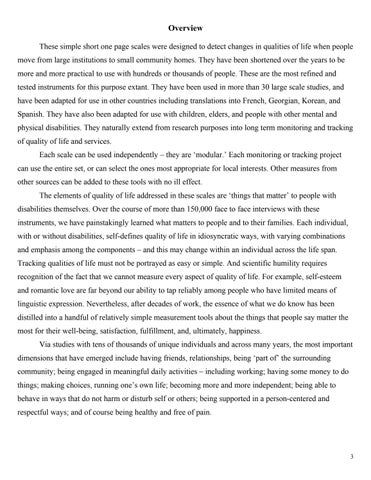Overview These simple short one page scales were designed to detect changes in qualities of life when people move from large institutions to small community homes. They have been shortened over the years to be more and more practical to use with hundreds or thousands of people. These are the most refined and tested instruments for this purpose extant. They have been used in more than 30 large scale studies, and have been adapted for use in other countries including translations into French, Georgian, Korean, and Spanish. They have also been adapted for use with children, elders, and people with other mental and physical disabilities. They naturally extend from research purposes into long term monitoring and tracking of quality of life and services. Each scale can be used independently – they are ‘modular.’ Each monitoring or tracking project can use the entire set, or can select the ones most appropriate for local interests. Other measures from other sources can be added to these tools with no ill effect. The elements of quality of life addressed in these scales are ‘things that matter’ to people with disabilities themselves. Over the course of more than 150,000 face to face interviews with these instruments, we have painstakingly learned what matters to people and to their families. Each individual, with or without disabilities, self-defines quality of life in idiosyncratic ways, with varying combinations and emphasis among the components – and this may change within an individual across the life span. Tracking qualities of life must not be portrayed as easy or simple. And scientific humility requires recognition of the fact that we cannot measure every aspect of quality of life. For example, self-esteem and romantic love are far beyond our ability to tap reliably among people who have limited means of linguistic expression. Nevertheless, after decades of work, the essence of what we do know has been distilled into a handful of relatively simple measurement tools about the things that people say matter the most for their well-being, satisfaction, fulfillment, and, ultimately, happiness. Via studies with tens of thousands of unique individuals and across many years, the most important dimensions that have emerged include having friends, relationships, being ‘part of’ the surrounding community; being engaged in meaningful daily activities – including working; having some money to do things; making choices, running one’s own life; becoming more and more independent; being able to behave in ways that do not harm or disturb self or others; being supported in a person-centered and respectful ways; and of course being healthy and free of pain.
3

